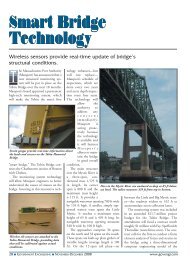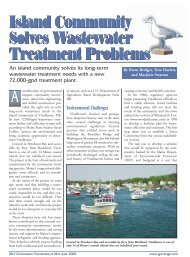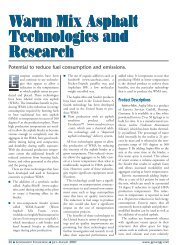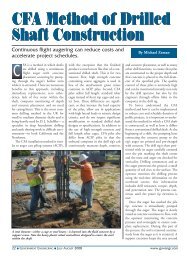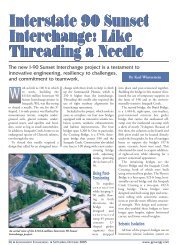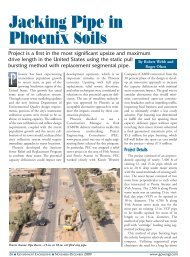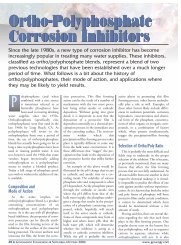Saipan's Solid Waste Management System - Government ...
Saipan's Solid Waste Management System - Government ...
Saipan's Solid Waste Management System - Government ...
- No tags were found...
You also want an ePaper? Increase the reach of your titles
YUMPU automatically turns print PDFs into web optimized ePapers that Google loves.
Saipan’s <strong>Solid</strong> <strong>Waste</strong><strong>Management</strong> <strong>System</strong><strong>System</strong> success is serving as an example toother South Pacific islands.An integrated solid waste managementsystem implementedon the island of Saipan hasproven so successful that otherneighboring South Pacificislands may follow suit.Saipan, population 78,252, is part ofthe U. S. Commonwealth of theNorthern Mariana Islands (CNMI), a15-island archipelago in the southPacific Ocean, north of Guam and eastof the Philippines. The CNMI is underthe jurisdiction of the EPA, Region 9.Saipan was the site of the Battle ofSaipan in World War II, and the nearbyisland of Tinian was the launch site forthe atomic bombing of Nagasaki andHiroshima that ended the war. After thewar, the Northern Mariana Islandsbecame part of the U. S. Navy TrustTerritories, and in 1978 they became aCommonwealth of the United States.In the early 1990s, the EPA issued acompliance order to the CNMI to closethe Puerto Rico Dump (PRD). ThePRD began as a military dump alongthe shoreline of the Saipan lagoon. Itwas unsightly, plagued with landfill firesand flies, near main tourist areas, andvisible from the main highway.By the late 1990s, daily soil cover wasbeing placed over the refuse, whichhelped control the fires and flies, butthere was increasing negative publicityfrom the media and the PRD was a sensitivetopic with the local tourism industry.A new landfill was needed. The goalfor a new solid waste system was notonly to bring Saipan into compliancewith federal environmental regulations,but also to utilize state-of-the-art wastereduction and diversion technologies.Plan ImplementationSources, composition, and quantitiesof waste going to the PRD were evaluatedand used to develop 20-year projections.A study revealed that 33 percentof Saipan’s solid waste stream was garmentwaste (Garment manufacturing isLandfill liner system is installed on the 12-acre waste management unit.By Steve Hiney and Ted Hawleythe island’s primary industry.) and othereasily divertible products.Because of Saipan’s remoteness andthe associated difficulties with operationsand maintenance, it was vital todevelop technologically simple solidwaste diversion, recycling, and disposalsystems. This eventually includedimplementation of diversion and recyclingprograms, a new solid waste transferstation/materials recovery facility—the Lower Base Refuse TransferStation—and a new RCRA Subtitle Dcompliant (Resource Conservation andRecovery Act—Subtitle D is the RCRAsection that covers municipal solidwaste.) municipal solid waste landfill—the Marpi <strong>Solid</strong> <strong>Waste</strong> Facility.Refuse Transfer StationThe $4.3-million Lower Base RefuseTransfer Station includes three structures—truckweigh scales and scalehouse, office/materials recovery facilitybuilding, and solid waste transfer building.The facility has on- and off-siteaccess roads and parking; an area forsorting, grinding, and storing greenwaste (vegetation); and all utilities(water, sewer, power, communications).The size and layout of theoffice/material recovery facility andtransfer building were determined basedon waste generation analyses. Theoffice/material recovery facility is a10,000-sq ft steel frame building housing22 employees and warehouse-typespace. The transfer facility is an 8,000 sqft steel frame and cast-in-place concretebuilding where residential/commercialvehicles can drop off solid waste forloading into rolloff bins for transport tothe landfill. A separate site developmentplan included development of an offsiteconstructed wetlands area for stormwa-www.govengr.com GOVERNMENT ENGINEERING ■ NOVEMBER–DECEMBER 2005 ■ 13
Aerial view of the Marpi <strong>Solid</strong> <strong>Waste</strong> Facility on theisland of Saipan in the South Pacific.ter treatment and offsite intersectionimprovements on a Federal HighwayAdministration highway.Marpi <strong>Solid</strong> <strong>Waste</strong> FacilityThe $9.4-million Marpi <strong>Solid</strong> <strong>Waste</strong>Facility (MSWF) includes site-supportfacilities (truck weigh scales and scalehouse, office building, maintenancebuilding), small-haulers drop-off area,diesel electrical power generation facility,12-acre lined waste managementunit, five-MG leachate storage pond,water and wastewater systems, stormwatercontrol systems, fuel storage systems,and site access roads and parking.The landfill is used only for disposalof municipal solid waste or other nonhazardouswastes. It is constructed ofmultiple refuse lifts, each composed ofnumerous refuse cells. The lifts aresloped to facilitate drainage and to minimizecover material requirements.Daily waste cell placement areas are keptto the smallest area practical for thewaste volumes received.There are numerous environmentalsafeguards in place. Four groundwatermonitoringwells are tested quarterlyand there are stringent load inspectionrequirements in place—waste designatedas prohibited is not accepted. Somesafeguards include:■ A daily six-in. soil cover minimizesinfiltration of water into the refuse,controls odors, reduces windblownlitter, and provides support fortrucks or vehicles. Soil cover materialis stockpiled adjacent to the landfill.■The landfill liner system includes ageosynthetic clay liner, a welded 60-mil high-density polyethylene(HDPE) geomembrane, a geocompositedrainage layer, andoverlying soil operationslayers.■ A leachate collection systemwas installed tofacilitate detection, sampling,and removal ofany leachate generated tothe landfill. It consists ofa rock drainage layerwith six-in. diameterHDPE lateral pipes.Drainage from the lateralpipes flows into a sixin.diameter HDPEmain pipe and on to the leachatesumps. The leachate is removed bypumps installed in 18-in. diameterHDPE sump riser pipes. The mainpipes extend to the surface of thelandfill adjacent to the sump riserpipes to allow future servicecleanout. The HDPE sump riserpipes and main pipes extend aboutthree ft above the final cover grade.Costs and BenefitsPlanning, engineering, and constructionof the Saipan solid waste managementsystem was funded 80 percent bythe U. S. Department of the Interior,Office of Insular Affairs; and 20 percentby the CNMI.Between January 2004 and June 2004,the MSWF received and managed19,564 tons of materials. About 12,542tons have been sent to the landfill, adiversion rate of about 36 percent.Garment waste has been declining dramaticallyover the past year due to thelifting of quotas and reduction of internationaltrade barriers. It now comprisesa much smaller fraction of the wastestream than what was discovered duringthe initial waste characterizations—1,348 tons or six percent. Other types ofdiverted materials (tons) were:■ Greenwaste—1,228.57■ Soil—479.91■ Concrete—408.02■ Cardboard—318.4■ White goods—74.33 (refrigerators,stoves, washers, dryers)■ Used tires—64.54 tons■ Glass—28.23■ Office paper—16.36■ Aluminum—12.15■ Old newsprint—1.13■ Plastic bottles—1.10Self-haul residential users do not haveto pay fees unless they exceed a 500-lblimit. The current tipping fee is $25 perton; special handling tipping fees are$35 per ton.EducationPrograms established to address solidwaste are only one part of the broadergoal of Saipan’s residents and businessesbecoming more environmentallyresponsible. The CNMI OrganizationInitial excavation of the lined waste management unit at the Marpi <strong>Solid</strong><strong>Waste</strong> Facility.14 ■ GOVERNMENT ENGINEERING ■ NOVEMBER–DECEMBER 2005 www.govengr.com
assessments wereconducted to promotesustainablepractices at two ofSaipan’s largesthotels.■ Handoutsare provided to allcustomers as theyarrive at the facilities.■ Ads aboutthe solid wastemanagement systemare frequentlyThe sun sets on <strong>Saipan's</strong> solid waste disposal problems.run in CNMIpapers and magazines, some ofwhich include Island Locator andBeach Magazine.of Conservation Outreach (COCO) wasrecently established, comprised of representativesof the CNMI Department ofEnvironmental Quality, CNMI CoastResources <strong>Management</strong>, CNMIDirector of Fish & Wildlife, CNMIPublic School <strong>System</strong>, and a number ofother agencies to provide a coordinatedenvironmental message. Last November,for example, Saipan participated in“America Recycles Day” by conductinga contest in the schools to see which onecould collect the most material (aluminumcans).Other projects have included:■ Purchasing 30 minutes of time onthe local TV channel (KCMI) forcontinuous play of a video producedon solid waste management. CNMIintends to expand the show’s contentsoon to address other environmentalissues such as coral reef, non-indigenousspecies, and non-point pollutionissues.■ Quarterly presentations are made toeach of the 19 public and ten privateschools on Saipan that focus on solidwaste and recycling efforts.■ A curriculum is being developed thatwill eventually be implemented fromgrades K-12 that will teach studentsabout the environment.■ “Cash for Trash” is an ongoing programthat pays residents to clean upand recycle appropriate materialsfrom sites that have been previouslyused as informal dumps.■ A series of community educationevents was held to inform the publicabout solid waste planning issues.<strong>Waste</strong> prevention and recyclingThe FutureThe CNMI has made great strides inaddressing solid waste managementissues. In fact, other South Pacific islandshave expressed an interest in learningmore. CNMI, for instance, recentlyhosted a training session funded by theU. S. Department of the Interior, Officeof Insular Affairs (DOI/OIA), thatincluded attendees from Palau,Federated States of Micronesia,American Samoa, Guam, and Yap. Thistraining was held on Saipan and theattendees included both operators andregulators. The basic concepts of solidwaste management were covered. Theseincluded development of a reasonablewaste generation estimate, environmentalcompliance, financing systems, andbasic day-to-day operations. The solidwaste management system was also recognizedby the <strong>Solid</strong> <strong>Waste</strong> Associationof North America (SWANA), whichawarded CNMI a Silver <strong>Solid</strong> <strong>Waste</strong><strong>Management</strong> <strong>System</strong> Award. GEMr. Hiney (dpwsolidwaste@vzpacifica.net) isthe <strong>Solid</strong> <strong>Waste</strong> Program Manager,Commonwealth of Northern Mariana Islandsand Mr. Hawley (wthawley@mactec.com) is aSenior Principal Engineer, MACTEC, Inc.,based in Anchorage, AK.www.govengr.com GOVERNMENT ENGINEERING ■ NOVEMBER–DECEMBER 2005 ■ 15



